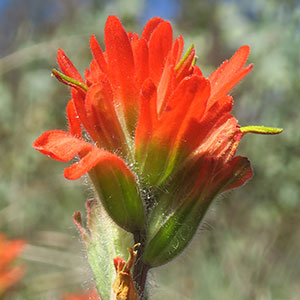Castilleja brevilobata
Castilleja integra
short-lobed paintbrush
entire-leaf paintbrush, foothill paintbrush, Southwestern paintbrush, squawfeather, wholeleaf Indian paintbrush, wholeleaf paintbrush
solitary or few, erect or ascending, unbranched, sometimes branched, hairs spreading, short, medium, and long, soft, short and medium ones short stipitate-glandular.
solitary or few to several, erect to ascending, less commonly bent at base, unbranched, sometimes branched distally, hairs spreading to appressed, fairly short, soft and moderately dense, matted, unbranched, not quite obscuring surface.
green or ± yellow, lanceolate, elliptic, or oblong to narrowly ovate, 1–2(–2.5) cm, not fleshy, margins plane or wavy, involute, (0–)3–5(–7)-lobed, apex rounded to acute;
lobes ascending to erect, linear to lanceolate, apex rounded to acute.
green to purplish, linear to lanceolate or narrowly oblong, (1–)2–7(–9) cm, not fleshy, margins plane, sometimes ± wavy, involute, 0-lobed distally, sometimes 3-lobed, apex acute to acuminate, sometimes rounded.
3–20 × 2–3.5 cm;
bracts proximally greenish to dull brown, distally red, orange-red, or scarlet, sometimes orange or yellow, broadly lanceolate or oblong, (0–)3–5-lobed;
lobes ascending, broadly to narrowly lanceolate, short, arising above mid length, apex acute, obtuse, or rounded.
2–12(–15) × 1.5–4 cm;
bracts red to red-orange or orange throughout, sometimes crimson, cerise, pale salmon, or pale yellow throughout, or proximally pale green to straw colored, distally colored as above, proximal sometimes narrowly lanceolate, others elliptic to narrowly elliptic, oblong, obovate, or oblanceolate, 0–3(–5)-lobed;
lobes ascending, lanceolate, short, arising at or above mid length, central lobe apex obtuse to rounded, lateral ones acute.
straight, 15–24(–26) mm;
tube 12–16 mm;
beak exserted, abaxial lip equal to calyx;
beak adaxially green or ± yellow-green, 7–10 mm, puberulent, stipitate-glandular;
abaxial lip deep green, reduced, rounded, 1–2 mm, 10–25% as long as beak;
teeth incurved to erect, light green, 0.5–1 mm.
straight or slightly curved, (21–)25–45(–50) mm;
tube 17–30(–33) mm;
beak subequal to calyx or strongly exserted, adaxially green, (8–)10–17(–18) mm;
abaxial lip deep green, reduced, usually visible in front cleft, 1–2.8 mm, 20% as long as beak;
teeth incurved, green or yellow, 0.5–1.5 mm.
green or whitish with green veins, lobes colored as bract lobes or paler, 14–30 mm;
abaxial and adaxial clefts 5.5–8.5 mm, 30–40% of calyx length, deeper than laterals, lateral 1.5–4 mm, 20–25% of calyx length;
lobes oblong to narrowly triangular, apex obtuse to rounded.
colored as bracts, (18–)21–35(–38) mm;
abaxial and adaxial clefts (6–)9–16(–18) mm, 25–33% of calyx length, deeper than laterals, lateral (2–)4–14(–16) mm, 10–15% of calyx length;
lobes lanceolate or triangular, apex acute to rounded.
= 24.
= 24, 48.
Castilleja brevilobata
Castilleja integra
Castilleja brevilobata is endemic to dry serpentine openings in the Siskiyou Mountains of southwestern Oregon and adjacent California. Although sometimes treated as part of C. applegatei or C. hispida, its morphology does not suggest a close connection with either. This species occasionally hybridizes with C. pruinosa in Del Norte County, California.
(Discussion copyrighted by Flora of North America; reprinted with permission.)
Castilleja integra is widespread and common in the southwestern United States. It is important to Native Americans for dyes, ceremonies, as a food preservative, and as a medicine. It is sometimes confused with C. lanata or C. miniata but has a distinctive combination of entire, narrow, strongly involute leaves, soft-tomentose pubescence of unbranched hairs, and usually entire bracts, sometimes with one pair of short lobes from the middle. The leaf margins of C. integra are usually plane, but some populations in the Chisos Mountains of Texas are wavy margined. These plants are on the higher slopes of the Chisos Mountains in montane thorn-oak vegetation, and they are also often taller and have longer, more frequently lobed leaves. These variant populations have been called C. elongata, and they deserve further study. Castilleja integra is typically a species of dry grasslands and open forests at moderate elevations. Occasional hybrids with C. linariifolia are known from Montrose County, Colorado.
The Castilleja elongata form of C. integra is in the Center for Plant Conservation’s National Collection of Endangered Plants.
(Discussion copyrighted by Flora of North America; reprinted with permission.)


